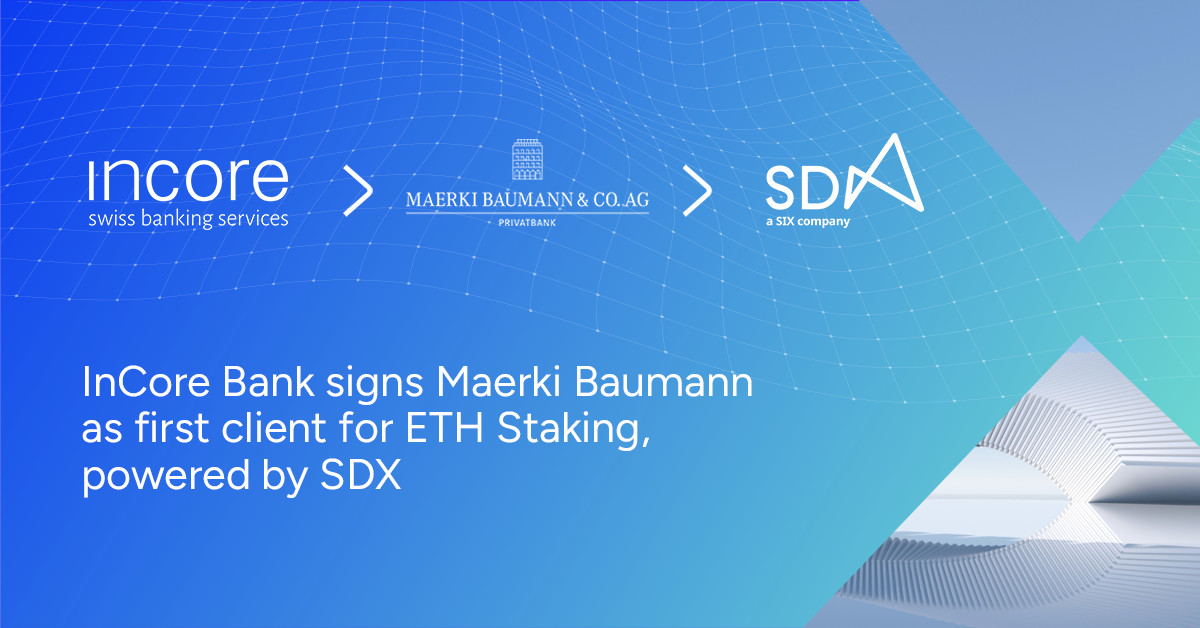InCore Bank will offer Ethereum (ETH) staking to their clients using SDX Web3 services. ETH staking will become an important yield opportunity when the upcoming Shapella Release is implemented as this will enable the withdrawal of ETH coins that are allocated to staking.
InCore Bank can now offer Ethereum staking capabilities that are fully compliant with Know-Your-Client (KYC) and Anti-Money-Laundering (AML) regulations to their clients. In this collaboration, InCore Bank provides crypto brokerage, banking operations and custody services, while SDX Web3 provides crypto custody and non-custodial-staking services.
The Zurich-based private bank Maerki Baumann launched its crypto strategy in 2019. Apart from corporate accounts for companies focusing on blockchain technology and crypto applications, it offers services in crypto trading and custody in collaboration with InCore Bank. Maerki Baumann will continue to expand its crypto offering by making the new Ethereum staking services available to its private and corporate tech banking clients.
Mark Dambacher, CEO InCore Bank, stated, «We perceive an increasing interest in staking and ways to participate in the decentralized economy. InCore Bank’s fully integrated and future-oriented staking services via segregated wallets, enable us to offer staking to our clients within a convenient, secure, regulated and tax compliant setting. We are proud to be part of this strategic alliance with SDX».
David Newns, Head of SDX, adds
«This collaboration between established digital asset institutions is the first of its kind in Switzerland. We are strengthening the Swiss digital asset ecosystem by enabling key market players to provide value adding capabilities like Ethereum custody and staking that their clients are asking for».
What is staking?
Blockchain networks are based on the principle of decentralisation, there is no central entity that decides on the correct transaction history. Nevertheless, a consensus mechanism is needed to ensure in a decentralized pattern that transactions are validated in correct order and in a secure manner. Blockchains typically reach consensus in two ways, either by so-called Proof-of-Work (PoW) or Proof-of-Stake (PoS) mechanisms.
In PoS blockchains like Ethereum, to guarantee consensus, no power-intensive computing power is used. Rather, capital needs to be expended in the form of the blockchain’s own coin. These coins must be «staked», i.e. made available to the network and bound by it for the staking period. For individuals who hold digital assets of proof-of-stake networks, staking is mandatory in order to avoid dilution of their own position. Due to this fact, it can be assumed that in the near future, there will be an increasing merger of custody and staking.
Staking is an umbrella term used to denote the act of pledging crypto-assets to a cryptocurrency protocol to earn rewards in exchange. Staking allows users to participate in securing the network by locking up tokens. The «stakers» become validators who add new transactions to the respective blockchain. At the same time, the validators follow the so-called consensus rules. These set the rules of the game according to which the various network participants have to comply. If, as a validator, you violate the network’s consensus rules during this process, you put your own capital at risk in the form of the coins you have staked. This ensures validators have an incentive to abide by the rules.
Source:
- Press Release InCore Bank, April 5, 2023 German Version for Bitcoin News Switzerland
- Press Release InCore Bank, April 5, 2023 Version in English Language for Bitcoin News Switzerland

